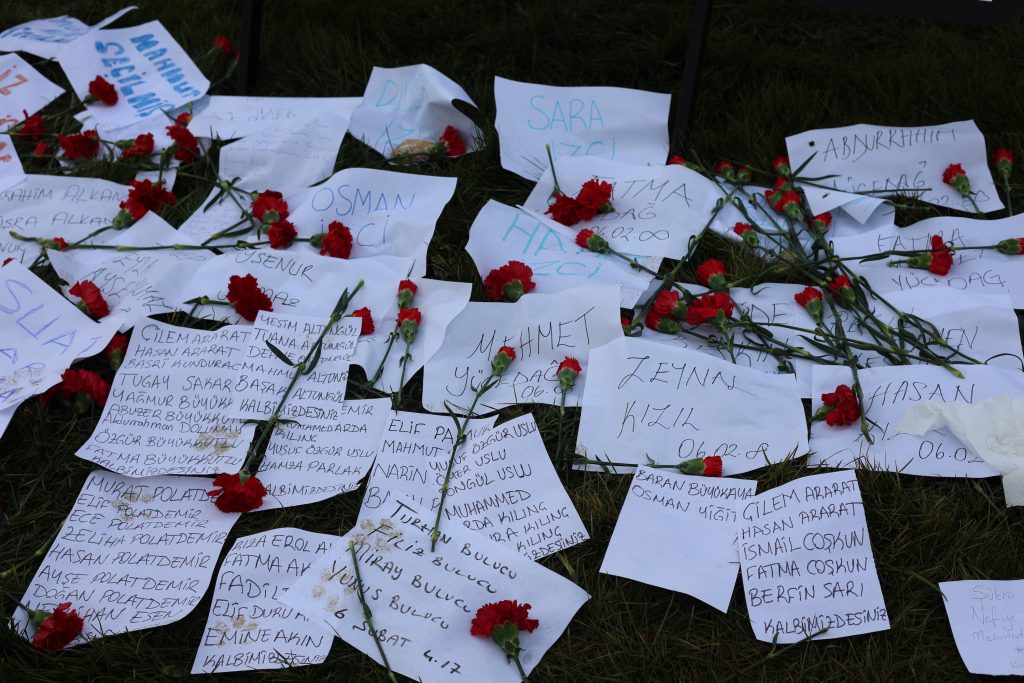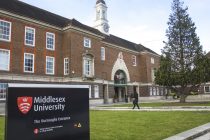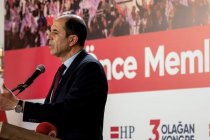Turkiye and the Turkish diaspora have marked the first anniversary of the devastating earthquakes that struck the country on 6 February 2023, causing widespread death and destruction. A wide range of emotions were on display at the commemoration events, from tearful to thankful, hopeful and angry.
In towns and cities across southeast Turkiye, which bore the brunt of the tremors’ devastating impact, people left their homes in the early hours of Tuesday morning to make their way to public spaces where they assembled for 4.17am – the exact time last year when the first of two powerful earthquakes struck Gaziantep Province and the region.
The cold, damp misty pre-dawn air served as the backdrop for the sombre gatherings, where people – many of them survivors of this hugely traumatic event – came to grieve and remember.
They stood quietly, some sobbing, others reciting prayers or in deep reflection as they recalled those fateful hours last year where the world shook and buildings were flattened in an instant, killing and injuring tens of thousands of people.
As drone footage from the earthquake zone subsequently showed, the two earthquakes that struck just over nine hours apart, measuring 7.8 and 7.7 respectively, created a wasteland across much of Turkiye’s 11 affected provinces and in neighbouring Syria that will take years to heal.
“Can anyone hear me” chanted some, a reminder that many people who survived the earthquake died because help could not reach them fast enough.
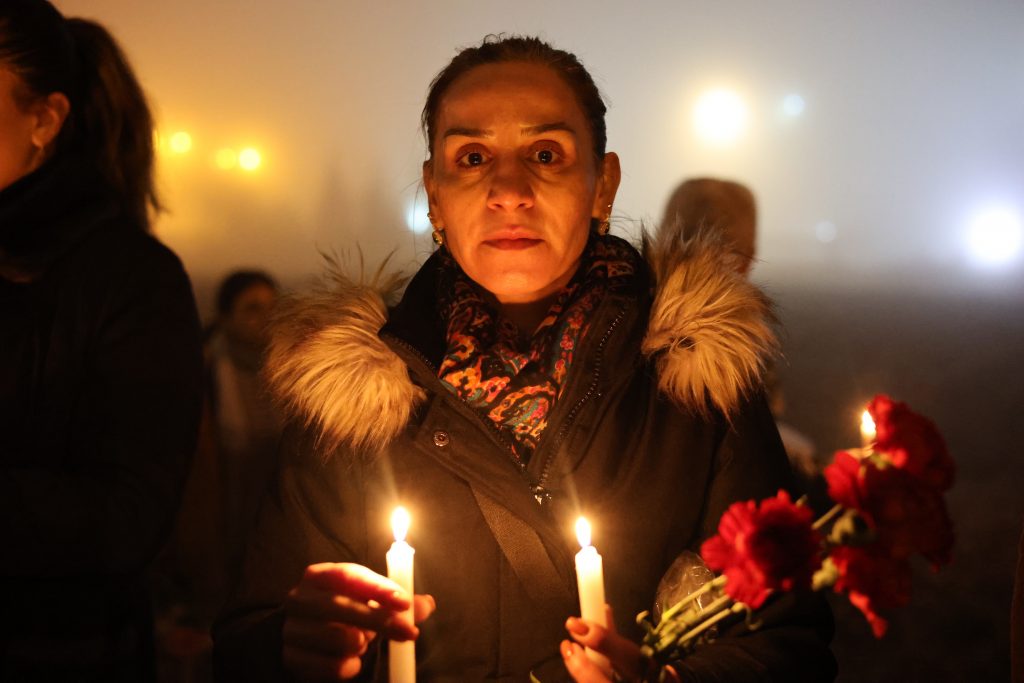
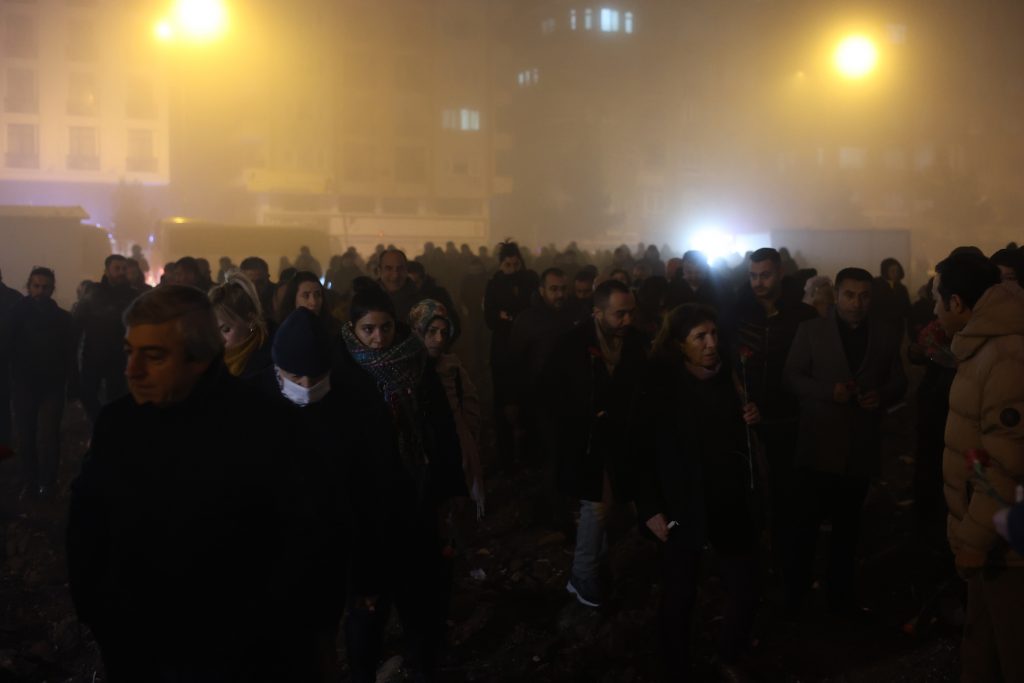
Those who had gathered in Hatay – one of the worst hit areas – jeered the politicians who had turned up. Health Minister Fahrettin Koca was booed, while the crowds chanted for Lütfü Savaş, the Mayor of Hatay where many people remain homeless, to resign. The two politicians, from opposing parties, had come to pay their respects, but instead needed police protection from the public.
In other commemorations, banners and notes reflected the anger and dismay of the local people as they mourned the loss of their loved ones. Some had a dig at the Turkish Red Crescent /Kızılay charity, which had been slammed for charging other charities last year for aid items needed for urgent relief work that had already been paid for by donations and government contributions.
Medine Mamedoğlu, a local journalist, attended several commemoration events an early morning gathering in Diyarbakır, or ‘Amed’, as the largely Kurdish local population prefer to call it.
“Those who lost their lives in the earthquake in Amed were commemorated. Each family member who lost a loved one walked among the rubble and mourned silently,” Mamedoğlu wrote as a caption to the images she captured on Tuesday morning.
They showed people of all ages coming together, some lighting candles, others laying down red carnations on the bare earth where once buildings had stood.
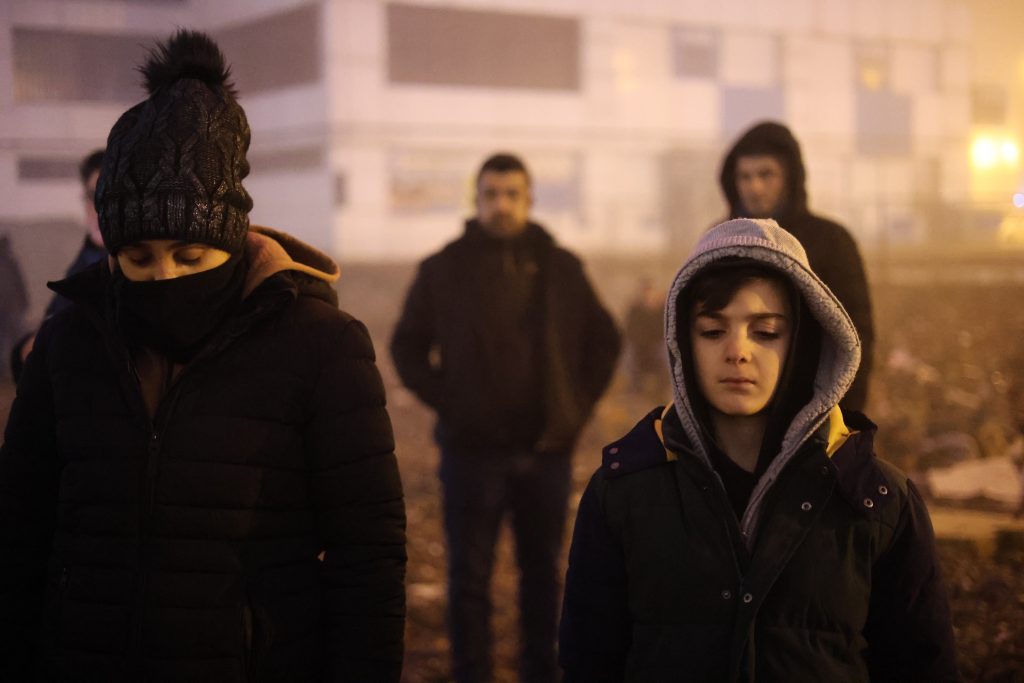
At another commemoration event in Adıyaman (Semsûr in Kurdish), there were paper notes bearing the names of the people who had been killed. Others chose to create a more permanent tribute, writing the names of the victims on nearby commemoration walls.
“Serhan Özdemir, we will not forget you”
One note on white paper, written in Kurdish, paid tribute to Serhan Özdemir, a local lawyer from Diyarbakır: “Dear friend of our people, Serhan Özdemir, we will not forget you”.
Özdemir died in the 6 February earthquake along with seven members of his family – Samed, Süheylan, Fatoş, Serrah, Nehir, Irmak, and Buket Özdemir. They became trapped under the rubble of their home in a five-storey building known as Diyar Galeria, on Elazığ Caddesi in the Yenişehir district of Diyarbakır.
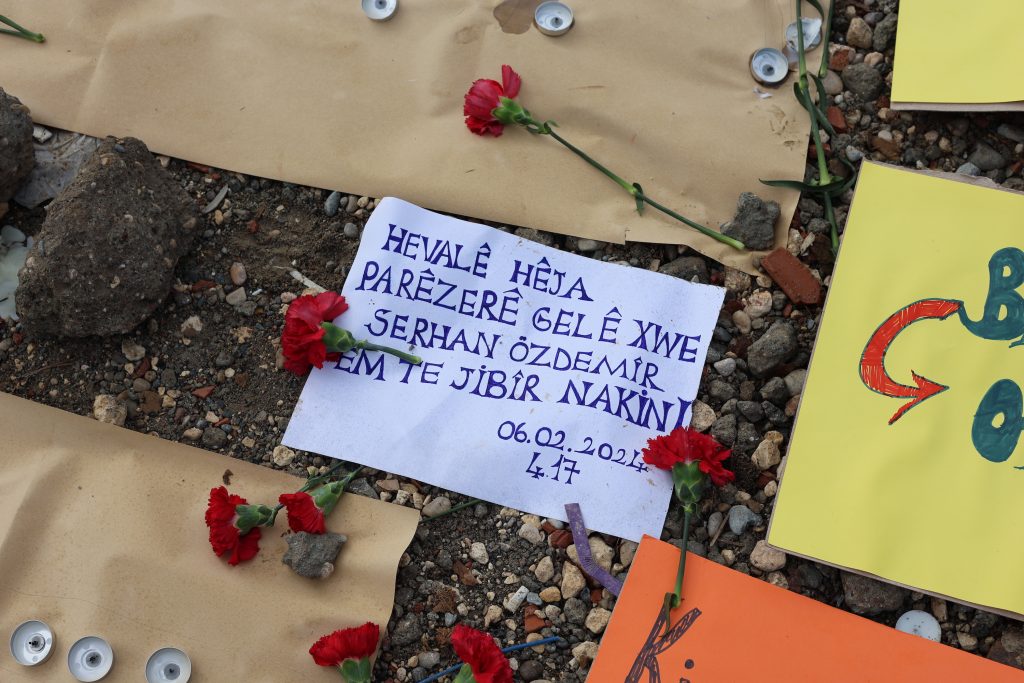
Relatives of the Özdemir family complained about the lack of help from the authorities, with rescue workers only reaching the site nine days after the earthquake, by which time all eight members of the family had died.
Serhan Özdemir was a well-known and highly respected human rights defender, who had become more prominent through his work as a member of the Diyarbakır / Amed branch of Özgürlük İçin Hukukçular Derneği (Association of Lawyers for Freedom ÖHD), using his legal skills to fight for those whose rights had been violated, including women and Kurds.
Last year, Özdemir had launched a lawsuit against the owners of the supermarket located on the ground floor of Diyar Galeria where his home was. He accused them of making the building structurally unsafe by removing vital support columns in the supermarket.
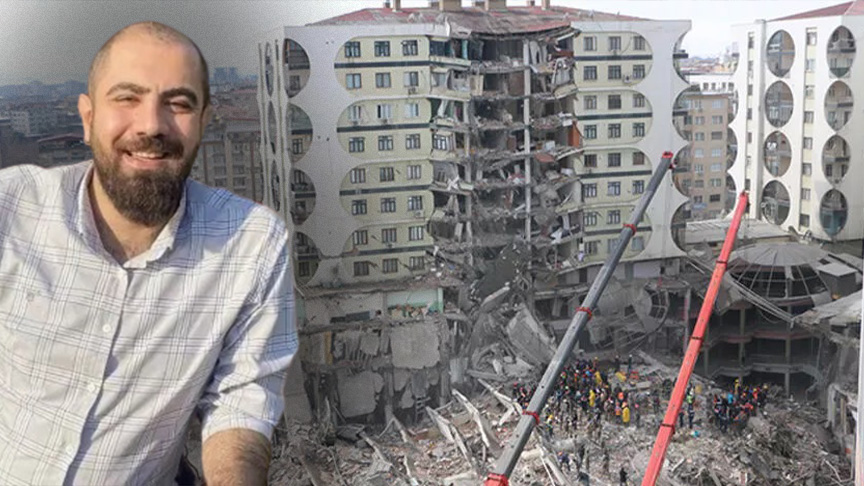
Özdemir was unable to conclude the case before his death, but his fears and accusations proved to be correct, as the entire building was flattened following the 6 February earthquake.
The tragic story of the Özdemir family echoes thousands of others in Turkiye who lost their lives in collapsed buildings made unsafe through illegal structural alterations coupled with the lack of effective oversight from the local authorities to ensure builders and property developers were adhering to Turkiye’s robust building regulations.
Justice for the victims of Isias Hotel
Twelve months on from modern Turkiye’s worst natural disaster, many are now seeking justice against building owners and others deemed responsible for the flawed construction of property.
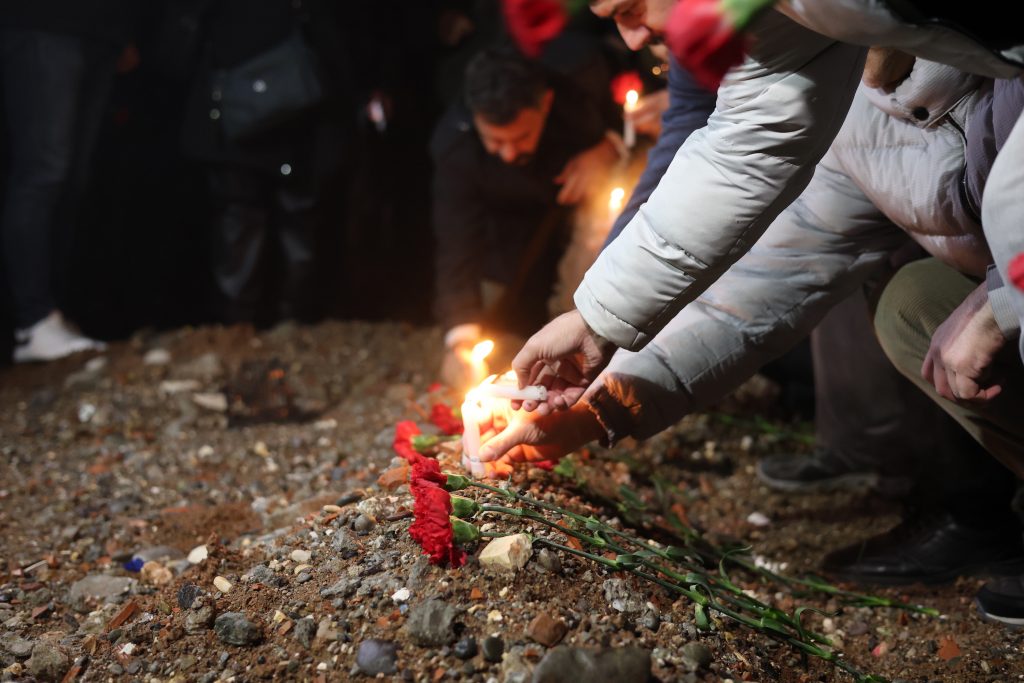
One of the most prominent cases involves a school party from North Cyprus who had been staying at the Isias Hotel in Adıyaman. The hotel collapsed ‘liked a pack of cards’ immediately after the first earthquake struck on 6 February, according to eyewitnesses, killing 35 of the 39-strong party that had comprised teachers, parents, pupils and several siblings.
The schoolchildren, mainly aged between 12 and 14 years old, were two teams of volleyball players, one boys and one girls, from Gazimağusa Türk Maarif Koleji [Gazimağusa Turkish Education High School] that had travelled to Turkiye to participate in a schools’ tournament.
As soon as news broke their hotel had collapsed, their families rushed to Adıyaman from North Cyprus, while the TRNC government sent over a specialist rescue team and machinery to help dig out the group trapped under the rubble. Unfortunately, they could only save four people. All 25 children died along with ten adults after being crushed in their rooms located on the second and fourth floors of the 10-storey building. The loss of 35 people marked the single largest number of deaths among Turkish Cypriots since the 1974 War.
View this post on Instagram
The Isias Hotel had also undergone major structural modifications. Relatives claim in their lawsuit that these changes coupled with the use of inferior quality building materials had made the building unsound and incapable of withstanding earthquakes. The owners reject all the charges and the trial, which is being heard at Adıyaman’s criminal court, has been adjourned until April.
Determined to keep the memories of their children – nicknamed the Şampiyon Melekler [Champion Angels] – alive, the parents took part in several events on Tuesday to mark the first anniversary of the tragedy.
Lanterns were lit on a major roundabout in the school’s hometown, prayers were said at the graveside of the victims where TRNC President Ersin Tatar and his wife and First Lady Sibel Tatar joined bereaved relatives. The group then released white balloons in remembers of the Şampiyon Melekler.
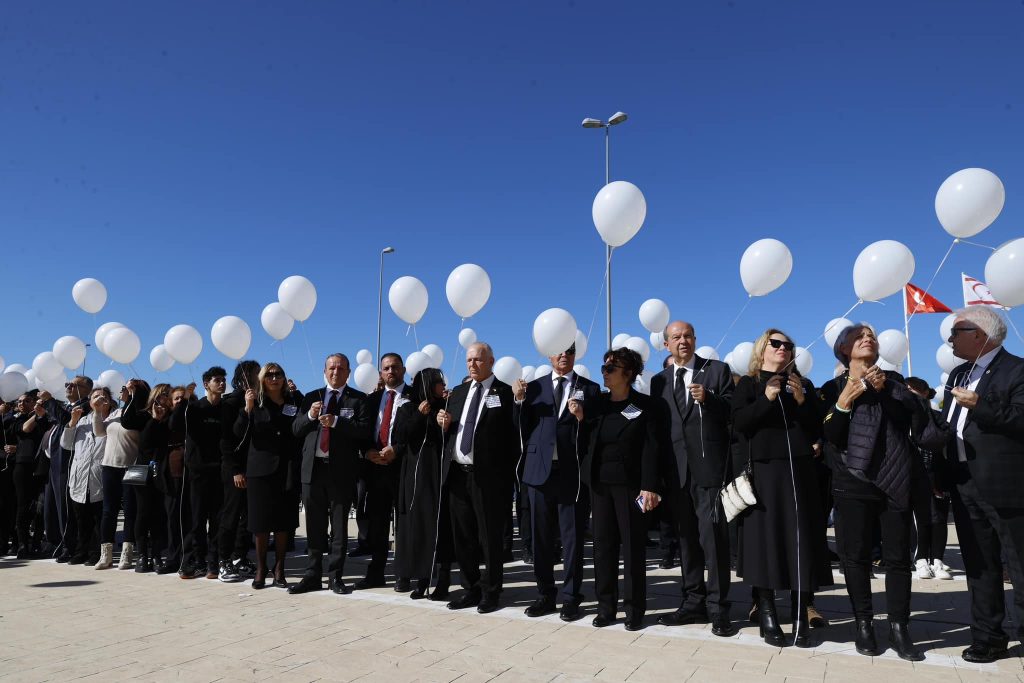
Videos of songs written in tribute to the Şampiyon Melekler, which featured their pictures, were shared across social media, while many turned their profile pictures to those created by the Şampiyon Melekler Association.
Fundraising
British Turks, who had been part of an urgent global campaign to get vital relief into the 15 million survivors displaced by the earthquakes by collecting tonnes of aid and raising millions of pounds through fundraising, came together again this year to remember those they had lost.
Alongside the mosques, Cemevis and community groups, who rallied around to help people in Turkiye and Syria, were also British Turkish companies who provided major relief through large donations.
One of the largest came from Muslim travel company Halalbooking.com. Its Chief Marketing Office, Ufuk Seçgin, was in Türkiye when the earthquakes struck and saw and heard first-hand accounts of the devastation, which led to Halalbooking launching its own fundraising campaign, partnering with British Muslim charity Islamic Relief.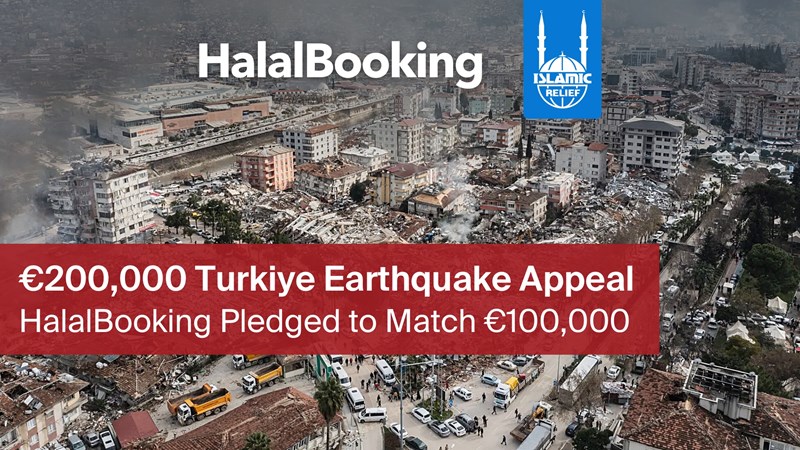
“Some of us are of Turkish origin, like myself, so we felt morally responsible to do something in this devastating crisis, the scale is unimaginable. Obviously as a company with hundreds of thousands of customers we felt there was an opportunity to take the lead to ask our customers to support us,” explained Seçgin.
Halalbooking.com pledged to match any donations their customers made, raising some €200,000 in the process. At the time of fundraiser’s launch, the company’s co-founder and CEO Elnur Seyidli said: “We see it as a duty and an obligation to repay the hospitality of the Turkish people by helping them in their darkest hour, in this time of great need.”
The money they raised is being used to rebuild homes and schools in some of the worst affected areas in Turkiye and Syria.
Tree-planting in London
Every Turk in the UK knew a person who had died or a family who had lost a relative. The impact of the earthquake felt very deep and very personal.
One of the commemorations held in London on Tuesday saw members of the British Alevi community come together in Bruce Castle Park in Haringey, North London, alongside members of the Turkish Police Association and Turkish, Kurdish and Turkish Cypriot heritage councillors from Haringey Council, including Council Leader Peray Ahment and TPA Head Eren Emin, to plant a tree in remembrance of those killed by the earthquake.
TPA Chair Eren Emin attended a ceremony today in Bruce Castle park hosted by @haringeycouncil & our dear leader @perayahmet, a memorial tree was planted to remember all those who lost their lives in the earthquake in #Türkiye & #Syria. @MPSHaringey#DepremiUnutmaUnutturma pic.twitter.com/oHx3mZ7pgG
— Turkish Police Association 🇹🇷🇦🇿🇬🇧 (@met_tpa) February 7, 2024
The plaque placed at the foot of the sapling tree states: “In memory of all those who lost their lives in the earthquakes in Turkey and Syria in 2023. With deep thanks to our Haringey community who came together to support those affected.”
A similar commemoration service took place in Edmonton’s Pymmes Park in the neighbouring borough of Enfield – home to the largest Turkish community in Britain. Led by the Mayor of Enfield Suna Hurman, local councillors and local MP Bambos Charalambous all helped plant a tree in memory of the Turkish and Syrian 2023 earthquake victims.
Mayor attended Pymmes Park to commemorate all those who lost their lives in the recent Turkish and Syrian earthquakes. A tree was planted in their honour by way of remembrance. pic.twitter.com/LEeXCyizQs
— Mayor of Enfield (@MayorofEnfield) February 6, 2024
“Disaster of the century”
Turkish President Recep Tayyip Erdoğan highlighted the raw feelings of loss in his post on X: “The unity of the century was displayed in the face of the disaster of the century”.
The first tremor, measuring 7.8 on the Richter, struck the west of Gaziantep in Gaziantep Province, which is near the border with Syria, at 4.17am. It is one of the strongest ever recorded in Turkiye, equivalent in magnitude to the 1939 Erzincan earthquake.
Gaziantep and Hatay Province’s capital city Antakya faced the full intensity of the first earthquake. At lunchtime that day, at precisely 1.34pm, the region was hit a second equally powerful earthquake measuring 7.7, which occurred 95 km north of the first one.
This photo by Adem Altan of a father holding his dead daughter’s hand is among the defining images of the 2023 Turkish earthquake
My heart breaks for this poor father.
As @GettyImages writes: “Mesut Hancer holds the hand of his 15-year-old daughter Irmak, who died in the earthquake.”
Please take a moment to think of and help the people of Turkey and Syria. Great options here: https://t.co/rLLFYo3x30 pic.twitter.com/ApzHsx24EC
— Jim Sciutto (@jimsciutto) February 7, 2023
Within 24 hours of the main quake, the region suffered a further 570 aftershocks. Over the next three weeks, more than 10,000 tremors have been documented. In total, there have been 57,015 aftershocks recorded during the past 12 months.
Official figures show 53,537 people killed in Turkiye and 107,213 injured in the disaster, while the International Blue Crescent placed the death toll in Syria at 8,476.
Over 15 million people were displayed in Turkiye and up to 4 million buildings damaged, including 850,000 that were totally destroyed by the twin quakes. Of these 680,000 were homes, the other 170,000 buildings were workplaces, warehouses and barns.
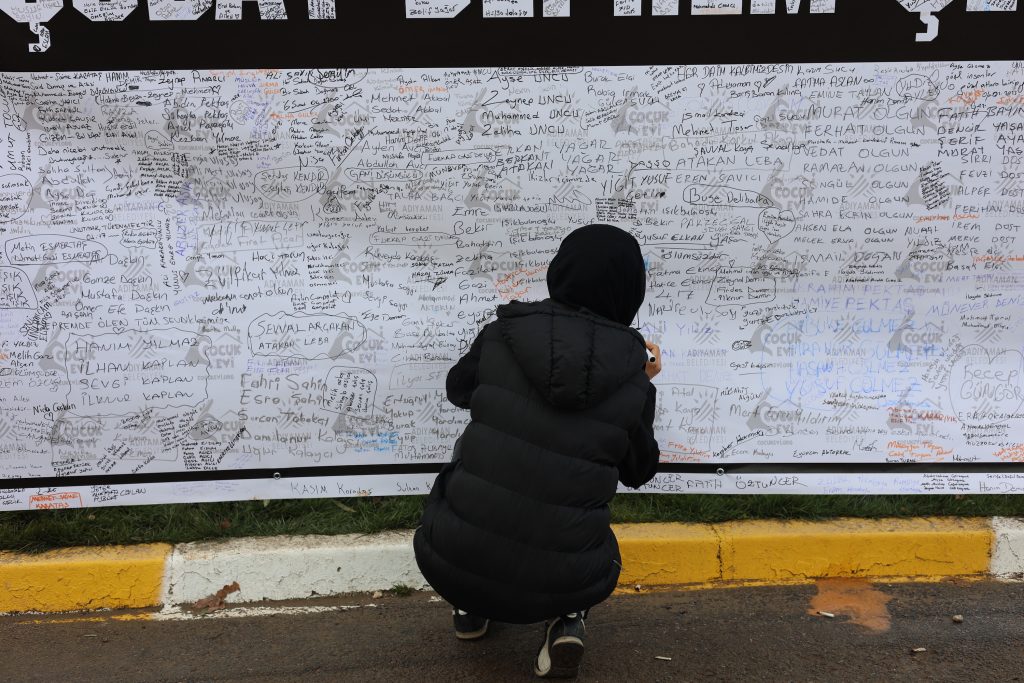
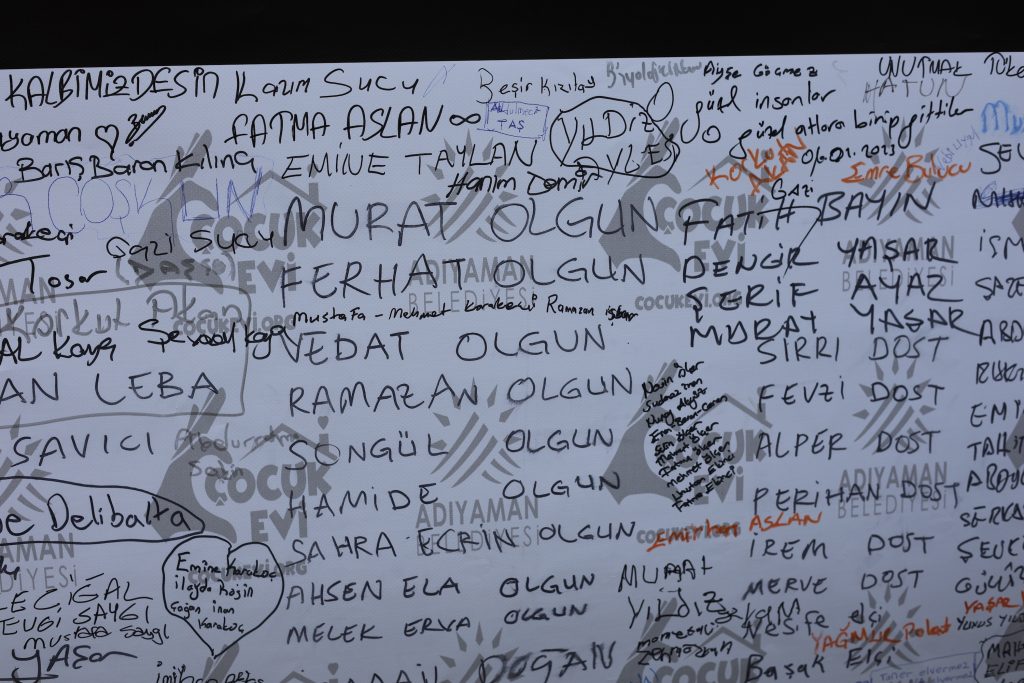
The World Bank estimated the damage caused by the earthquakes to be $34.2 billion. Yet the cost of constructing new homes and work places, and the overall impact on the economy proved to be far greater – some $100 billion, according to a report of the Economic Policy Research Foundation of Türkiye (TEPAV) on Tuesday.
New homes and new hope
In the wake of the disaster, the Turkish government pledged to build 680,000 new homes across 11 provinces over two years, a third of these in Hatay which was worst affected.
To date, 46,000 new homes have been constructed in cities, towns and villages in the southeast, while a further 307,000 homes are in the process of being constructed in cities, towns and villages. The government is also providing grants and loans for “on-site transformation projects”.
For the tens of thousands of displaced people who lost their homes on 6 February, they now reside in temporary accommodation, such as containers and prefabricated homes, and while all provide a sturdy and warm roof above their heads, the containers in particular are small for those with children, and the water and electricity supply to them often haphazard. Still many remain thankful to be alive and protected from the elements.
Local people assemble in Hatay on 6 February 2024 to protest over the government’s failings
While anger remains at the Turkish government for its handling of the rescue effort and for failing to act against the many sub-standard buildings, which were levelled by the earthquake killing thousands in the process, there are many Turks who speak highly of the state’s response, aware that no government could provide an adequate response given the magnitude of the disaster and the scale of the area the earthquake affected.
One person keen to express his happiness with the Turkish government is Yusuf Doğrukul, who told Anadolu Agency that his family live in peace after settling into their permanent new post-disaster home created for their village of Altınözü in Hatay.
Doğrukul was full of praise for the new village houses and those responsible for them: “May God bless our state and all those who contributed to it. May it not cause any harm. Our houses are very beautiful and we are very pleased.”
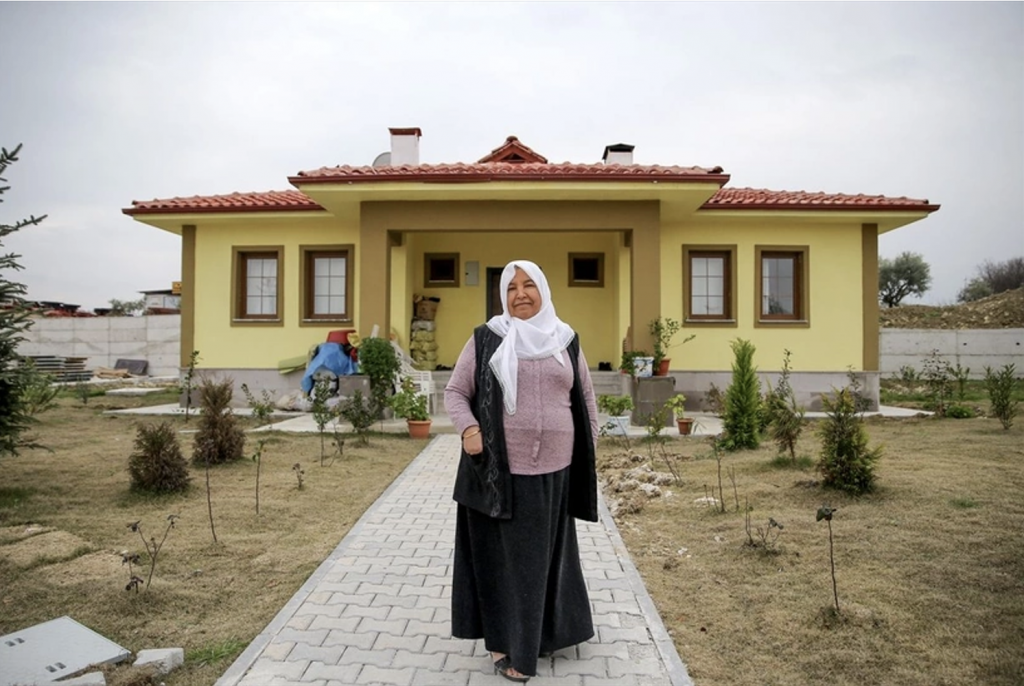
Another beneficiary is pensioner Ali Bahçeci, whose house was also damaged in the earthquake. He also expressed his gratitude with the house he had been given. “My house is very beautiful, thank God, I am satisfied.
“There is a big difference compared to the old house I lived in. Disaster houses are better. I am almost 70-years-old, I cannot build such a house. Even if I worked hard for another 70 years, I still couldn’t build such a house. Thanks to our government, we are able to live in such a house.”
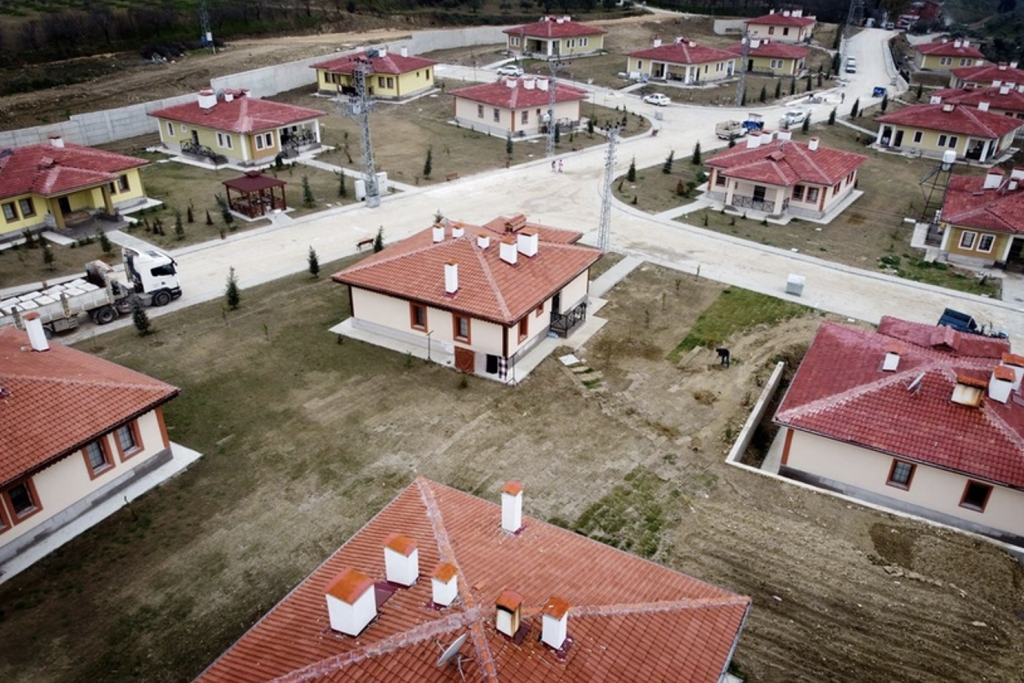
In places such as Hatay and Antakya, the impact of the earthquake remains clearly visible, with many damaged or collapsed buildings yet to be fully demolished and cleared away. Lots of families and businesses are struggling, deprived of one of the area’s main sources of income, tourists, coupled with the fact many local residents have moved away either due to the earthquake or the lack of local work or affordable rent.
It will take years before these once thriving towns and cities will recover, yet people remain hopeful and resilient. Shoemaker Mustafa Okay says the shop owners in Antakya’s Uzun Çarşı Bazaar are still struggling financially. But he is hopeful that life will improve in the coming months.
“I got loans from the banks and now I have to pay them back,” he said. “Business is sluggish for now, but I hope it will get better after the winter.”


